by Lance Roberts, Clarity Financial
Yesterday, the financial media burst into flames as the yield on the 10-year Treasury fell below that of the 2-Year Treasury. In other words, the yield curve became negative, or “inverted.”
“Stocks plunged on Wednesday, giving back Tuesday’s solid gains, after the U.S. bond market flashed a troubling signal about the U.S. economy.” – CNBC
According to CNBC’s logic, the economy was perfectly fine on Tuesday, notably as Trump delayed “tariffs” on China, since the yield curve was NOT inverted. However, in less than 24-hours, stocks are plunging because the yield curve inverted?
[backc url='https://sendy.advisoranalyst.com/w/J8pxsj3OgR4yxKxsA1169Q']Let’s step back for a moment and think about this.
Historically speaking, the inversion of a yield curve has been a leading indicator of economic recessions as the demand for liquidity exceeds the demand for longer-term loans. The chart below shows the history of yield curves and recessions.
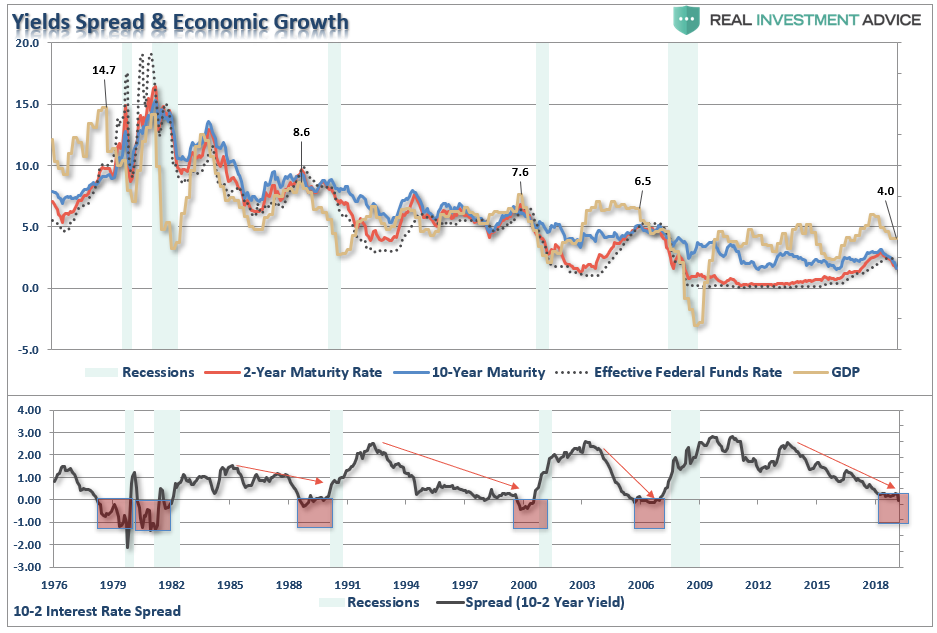
The yield curve has been heading towards an inversion for months, suggesting that something was “not healthy” about the state of the economy. In August 2018, I wrote, “Don’t Fear The Yield Curve?”
“The spread between the 10-year and 2-year Treasury rates, historically a good predictor of economic recessions, is also suggesting the Fed may be missing the bigger picture in their quest to normalize monetary policy. While not inverted as of yet, the trend of the spread is clearly warning the economy is much weaker than the Fed is suggesting. (The boosts to economic growth are now all beginning to fade and the 2nd-derivative of growth will begin to become more problematic starting in Q3)”
Despite the flattening slope of the yield curve, the mainstream media was consistently dismissing the message it was sending.
“There are always a lot of things to worry about in our economy — short range and long range. The yield curve, however. isn’t one of them. It just shows that some other people are worried, too. It doesn’t mean that they are right.” – James McCusker
“Contrary to what many people think, inverted yield curves don’t always sound the alarm to sell. In fact, looking at the past five recessions, the S&P 500 didn’t peak for more than 19 months on average after the yield curve inverted, along the way adding more than 22% on average at the peak,” – Ryan Detrick, LPL
“In fact, an inversion is often a buying opportunity. During each of the past seven economic cycles, the S&P 500 has gained in the six-months before a yield-curve inversion.” Tony Dwyer, analyst at Canaccord Genuity.
While the nearly inverted yield curve didn’t matter on Tuesday, it suddenly mattered on Wednesday? From the WSJ:
“It was a very bad day in the stock market on Wednesday. That big rally on Tuesday after the U.S. delayed some China tariffs? Completely erased, and then quite a bit more. The Dow Jones Industrial Average fell 800 points, or 3%, and the S&P 500 dropped 2.9%.
A big factor in the selling appeared to be concern over a brief drop in the yield on the 10-year Treasury yield below the yield on the two-year. Since such yield curve inversions have tended to occur ahead of recessions, worries that the U.S. is at risk of downturn got set off.”
We have been warning for the last 18-months that despite a sharp rise in volatility, the bull market that began in 2009 had likely come to an end. To wit:
“There is a reasonably high possibility, the bull market that started in 2009 has ended. We may not know for a week, a month or even possibly a couple of quarters. Topping processes in markets can take a very long time.
If I am right, the conservative stance and hedges in portfolios will protect capital in the short-term. The reduced volatility allows for a logical approach to further adjustments as the correction becomes more apparent. (The goal is not to be forced into a “panic selling” situation.)”
Don't run, walk.
The goal of portfolio management is NOT to be forced into a liquidation event. Such doesn’t mean you must try and “time the market” to sell at the peak (which is impossible to do), but rather being aware of the risk you are carrying and exiting the market when you choose. Being put into a position, either “emotionally” or “operationally,” where you are forced to liquidate always occurs at the worst possible time and creates the greatest amount of capital destruction.
With this premise in place, let’s review the S&P 500 over several different time frames and metrics to determine what actions should be considered over the next few days and weeks.
Daily
On a daily basis, the market is back to oversold. Historically, this condition has been sufficient for a bounce. The difference, however, is the current oversold condition (top panel) is combined with a “sell signal” in the bottom panel. This suggests that any rally in the markets over the next few days should be used to reduce equity risk, raise cash, and add hedges.
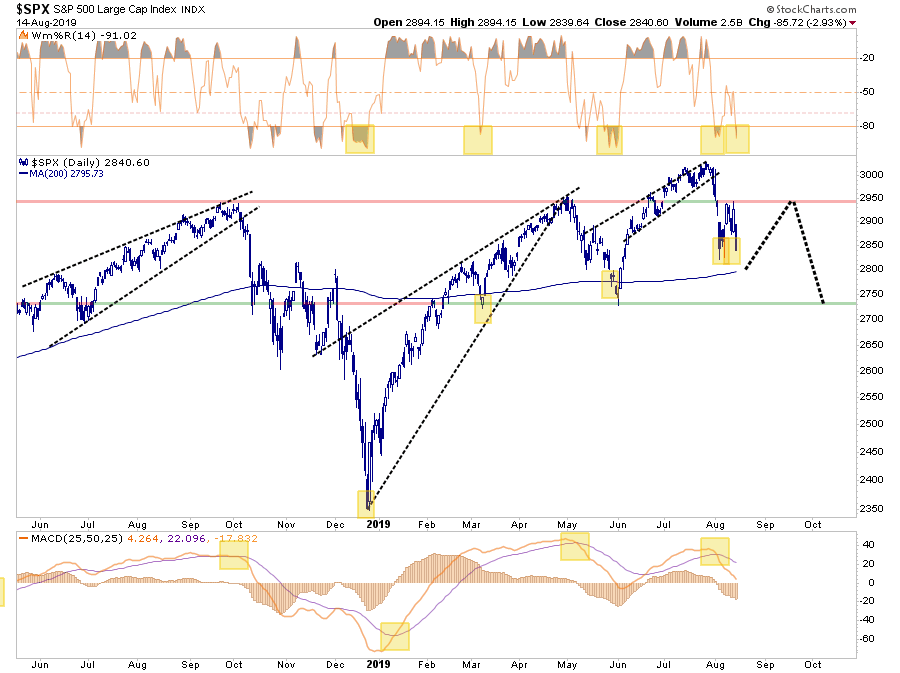
If we stretch the analysis out a bit, the “megaphone” pattern becomes much more apparent. The repeated failures at the upper trend line continues to complete a “broadening topping process,” which is more suggestive of a larger, more concerning market peak.
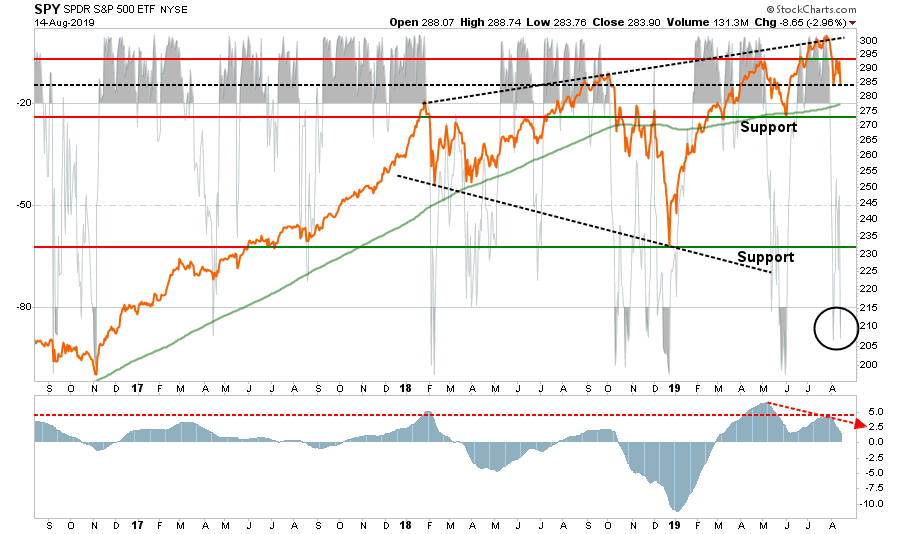
As with the chart above, the market is oversold on a short-term basis, and a rally from current support back to the 50-dma is quite likely.
Again, that rally should be used to reduce risk. I wrote about this on Tuesday in “5-Reasons To Be Bullish (Or Not) On Stocks:”
“For longer-term investors, it is worth considering the historical outcomes of the dynamics behind the financial markets currently. The is a huge difference between a short-term bullish prediction and longer-term bearish dynamics.As Howard Ruff once stated:
“It wasn’t raining when Noah built the ark.”
The following chart is a longer-term analysis of the market and is the format we use for “onboarding” our clients into their allocation models. (Vertical green lines are buy periods, red lines are sell periods.)
Notice that while the market has been rising since early 2018, the momentum indicators are negatively diverging. Historically, such divergences result in markedly lower asset prices. In the short-term, as noted above, the market remains confined to a rising trend which is running along the 200-dma. At this juncture, the market has not violated any major support points and does currently warrant a drastically lower exposure to risk. However, the “sell signals” combined with negatively diverging indicators, suggest a “reduction” of risk, and hedging, is warranted on any rally.
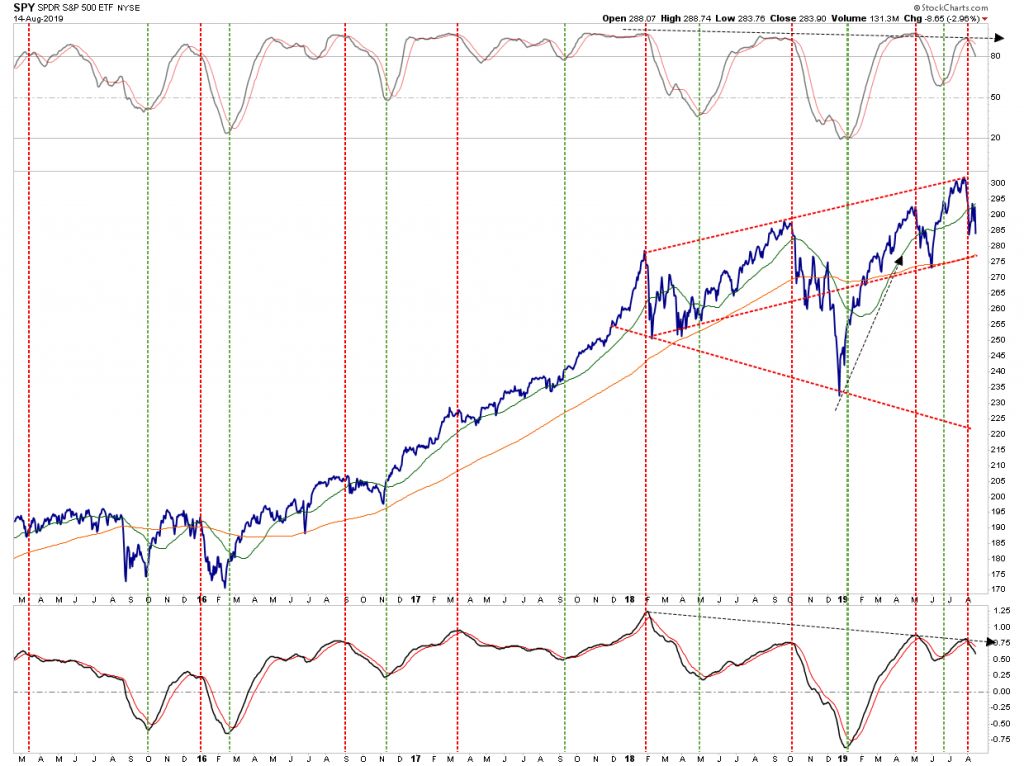
The analysis becomes more concerning as view other time frames.
Weekly
On a weekly basis, the rising trend from the 2016 lows is clear. The market has not violated that trend currently, which suggests maintaining some allocation to equity risk in portfolios currently. However, the two longer-term sell signals, bottom panels, are close to confirming each other, and suggests a more significant correction process is forming.
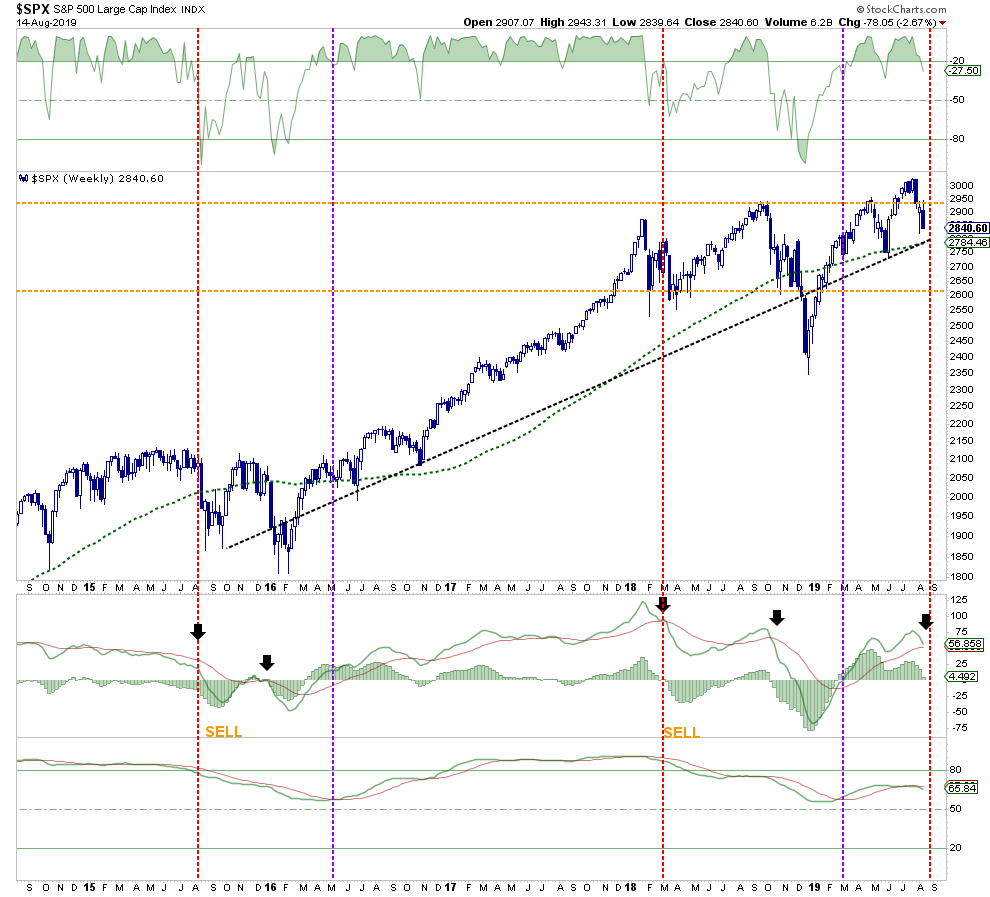
The market is still very overbought on a weekly basis which confirms the analysis above that short-term rallies should likely be sold into, and portfolios hedged, until the correction process is complete.
Monthly
On a monthly basis, the concerns rise even further. We have noted previously, the market had triggered a major “sell” signal in September of last year. These monthly signals are “rare,” and coincide with more important market events historically.
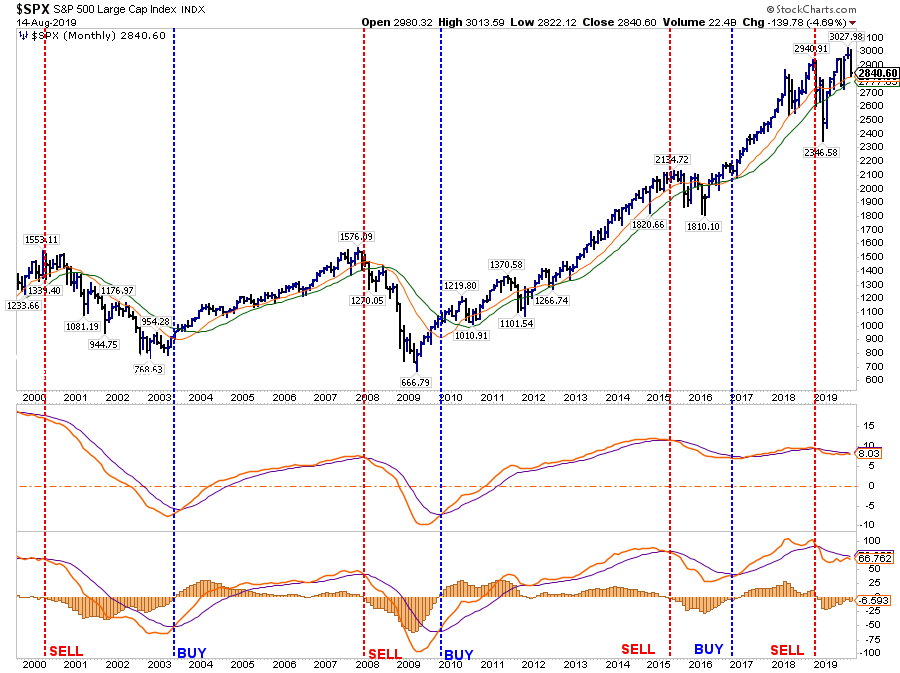
These signals should not be ignored.
Don’t Panic Sell
The purpose of the analysis above is to provide you with the information to make educated guesses about the “probabilities” versus the “possibilities” of what could occur in the markets over the months ahead.
It is absolutely “possible” the markets could find a reason to rally back to all-time highs and continue the bullish trend. (For us, such would be the easiest and best outcome.)
However, the analysis currently suggests the risks currently outweigh potential reward and a deeper correction is the most “probable” at this juncture.
Don’t take that statement lightly.
I am suggesting reducing risk opportunistically, and being pragmatic about your portfolio and your money. Another 50% correction is absolutely possible, as shown in the chart below.
(The chart shows every previous major correction from similar overbought conditions on a quarterly basis. A similar correction would currently entail a 53.7% decline.)
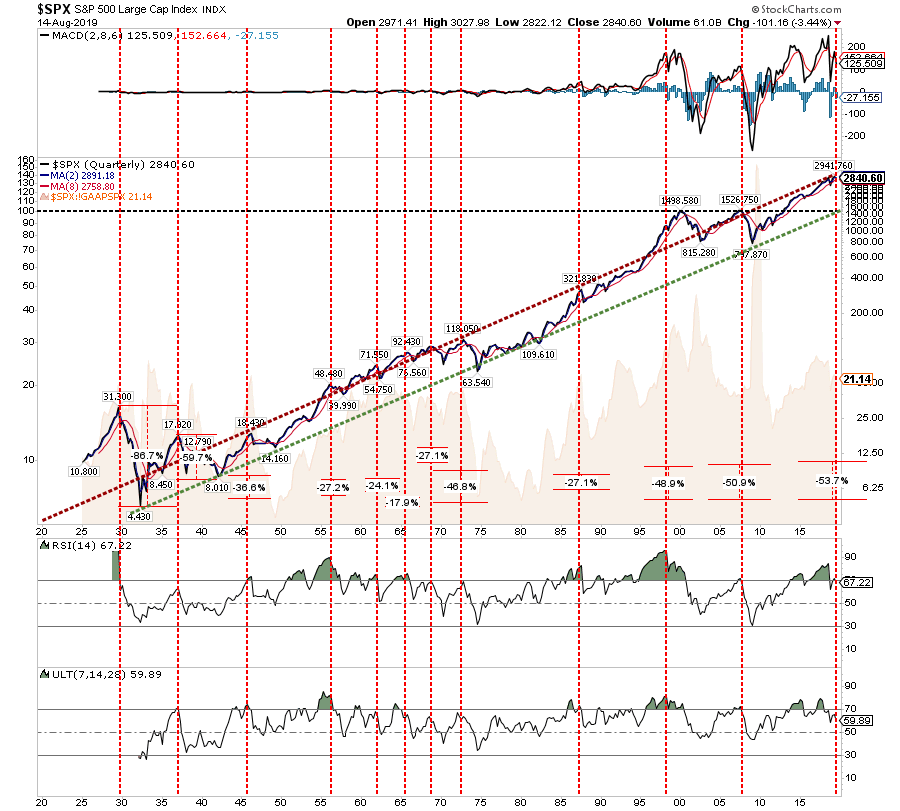
So, what should you be doing now. Here are our rules that we will be following on the next rally.
15-Portfolio Management Rules:
- Cut losers short and let winner’s run. (Be a scale-up buyer into strength.)
- Set goals and be actionable. (Without specific goals, trades become arbitrary and increase overall portfolio risk.)
- Emotionally driven decisions void the investment process. (Buy high/sell low)
- Follow the trend. (80% of portfolio performance is determined by the long-term, monthly, trend. While a “rising tide lifts all boats,” the opposite is also true.)
- Never let a “trading opportunity” turn into a long-term investment. (Refer to rule #1. All initial purchases are “trades,” until your investment thesis is proved correct.)
- An investment discipline does not work if it is not followed.
- “Losing money” is part of the investment process. (If you are not prepared to take losses when they occur, you should not be investing.)
- The odds of success improve greatly when the fundamental analysis is confirmed by the technical price action. (This applies to both bull and bear markets)
- Never, under any circumstances, add to a losing position. (As Paul Tudor Jones once quipped: “Only losers add to losers.”)
- Market are either “bullish” or “bearish.” During a “bull market” be only long or neutral. During a “bear market”be only neutral or short. (Bull and Bear markets are determined by their long-term trend as shown in the chart below.)
- When markets are trading at, or near, extremes do the opposite of the “herd.”Do more of what works and less of what doesn’t.(Traditional rebalancing takes money from winners and adds it to losers. Rebalance by reducing losers and adding to winners.)
- “Buy” and “Sell” signals are only useful if they are implemented. (Managing a portfolio without a “buy/sell” discipline is designed to fail.)
- Strive to be a .700 “at bat” player. (No strategy works 100% of the time. However, being consistent, controlling errors, and capitalizing on opportunity is what wins games.)
- Manage risk and volatility. (Controlling the variables that lead to investment mistakes is what generates returns as a byproduct.)
Everyone approaches money management differently. This is just our approach to the process of controlling risk.
We hope you find something useful in it.
Copyright © Clarity Financial













